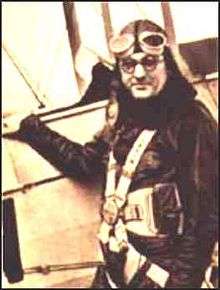Leslie Irvin (parachutist)

Leslie Leroy Irvin (10 September 1895 – 9 October 1966) made the first premeditated free-fall parachute jump in 1919. Irvin was born in Los Angeles. He became a stunt-man for the fledgling Californian film industry, for which he had to perform acrobatics on trapezes from balloons and then make descents using a parachute. Irvin made his first jump when aged fourteen. For a film called Sky High, he first jumped from an aircraft from 1,000 feet in 1914. He developed his own static line parachute as a life-saving device in 1918 and jumped with it several times.
Biography
Leslie Leroy Irvin was born on September 10, 1895. Adventurous and athletic and a protégé of Charles Broadwick,[1] Irvin made his first parachute jump when he was fourteen and jumped from an airplane for the first time in 1914, sailing 1,000 feet to the ground in a stunt for the movie Sky High.[2] He joined the Army Air Service's parachute research team, and at McCook Field near Dayton, Ohio.
After World War I, Major E. L. Hoffman of the Army Air Service led an effort to develop an improved parachute for exiting airplanes by bringing together the best elements of multiple parachute designs. Participants included Irvin and James Floyd Smith. The team eventually created the Airplane Parachute Type-A. This incorporated three key elements,
- storing the parachute in a soft pack worn on the back, as demonstrated by Charles Broadwick in 1906;
- a ripcord for manually deploying the parachute at a safe distance from the airplane, from a design by Albert Leo Stevens; and
- a pilot chute that draws the main canopy from the pack.
In 1919, Irvin successfully tested the parachute by jumping from an airplane. The Type-A parachute was put into production and over time saved a number of lives.[1] This was the first premeditated freefall parachute descent.[3] With Smith flying the plane and Irvin making the jump, the new chute performed flawlessly, though Irvin broke his ankle on landing.
Less than two months later, the Irving Air Chute Company was formed in Buffalo, New York, the world’s first parachute designer and manufacturer.[3] Legend has it that 'Irvin' was inadvertently changed to 'Irving' by a secretary who mistakenly tacked a 'g' on the end of the name,[4][5] and the company never bothered to correct the mistake until 1970.[2]
An early brochure[6] of the Irving Air Chute Company credits William O'Connor 24 August 1920 at McCook Field as the first person to be saved by an Irving parachute. Two years later, Irvin's company instituted the Caterpillar Club, awarding a gold pin to pilots who successfully bailed out of disabled aircraft using an Irving parachute.[3]
Irving Air Chute had become the largest parachute manufacturer in the world.[7] By 1939, 45 foreign countries were using Irving parachutes, including Germany, which had confiscated an Irving plant and bought its patents in 1936.[5] During the Second World War, Irving parachutes alone saved over 10,000 lives.
As aircraft flew at ever increasing altitudes, pilots and aircrew were subject to ever lower temperatures, and Irvin designed and manufactured the classic sheepskin flying jacket to meet aviators' special requirements.[8] Later the company also made car seat belts, slings for cargo handling, and even canning machinery. In 1970, the company finally removed the misnomic 'g' from its name, becoming Irvin Air Chute, and in 1996, changed its name again to Irvin Aerospace Inc.[2] In addition to parachutes, the company (now Airborne Systems) specializes in a diverse range of products for global aerospace and military markets.[9]
Leslie Irvin died on October 9, 1966.
References
- 1 2 Ritter, Lisa (April–May 2010). "Pack Man: Charles Broadwick Invented a New Way of Falling". Air & Space. 25 (1): 68–72. Retrieved March 1, 2013.
- 1 2 3 http://patriciahysell.wordpress.com/tag/parachute/
- 1 2 3 http://www.airborne-sys.com/pages/view/milestones
- ↑ http://tonawanda-news.com/local/x474413799/Ken-Ton-has-rich-aviation-history/
- 1 2 http://wnyheritagepress.org/photos_week_2008/irving_air_chutes/irving_air_chutes.htm
- ↑
- ↑ https://books.google.com/books?id=PlEEAAAAMBAJ&lpg=PP1&pg=PA28#v=onepage&q&f=false
- ↑ http://www.flying-jacket.com/about-irvin.aspx
- ↑ http://www.airborne-sys.com/pages/view/about-us